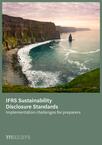Preparing for implementation challenges of IFRS Sustainability Reporting
For those now looking to report using the IFRS SDS, understanding its ambitions and assessing how prepared you are will help determine your ability to face those challenges.
Set reporting boundaries
Identifying the scope of the sustainability report is key. While establishing reporting boundaries for IFRS SDS is similar to that taken for financial statements, there are a number of additional considerations.
Among other things, entities must take into account the impact of annual changes in the group structure. Also, how to aggregate and disaggregate sustainability reporting to best reflect the difference between sustainability risks and opportunities and the financial position.
Establish strong foundations
Building strong foundations helps to ensure preparations move forward smoothly. An analysis of the policies, procedures and controls that need to be in place, along with the quantitative and qualitative data will help to establish what structures need to be strengthened or put in place.
To ensure that sustainability reporting meets global obligations you may be expected to meet, assessing extra-territorial impacts of sustainability reporting requirements under, for example, Europe’s Corporate Sustainability Reporting Directive (CSRD) or sustainability regulation developments in the US is essential.
Take an active approach to challenges
Actively preparing for the impact of challenges around data collection, value chain assessments and how you can utilise existing capacity or increase resources to meet reporting requirements is vital.
Initial steps to meet those challenges include ensuring you have sufficient expertise on sustainability matters. Further steps include reviewing risk management policies and processes to embed sustainability risk identification, assessment and mitigation to help establish the appropriate structures and reporting lines needed.
For more detailed guidance and practical steps to take on IFRS SDS, download our report: IFRS Sustainability Reporting Standards: Implementation challenges for preparers.

